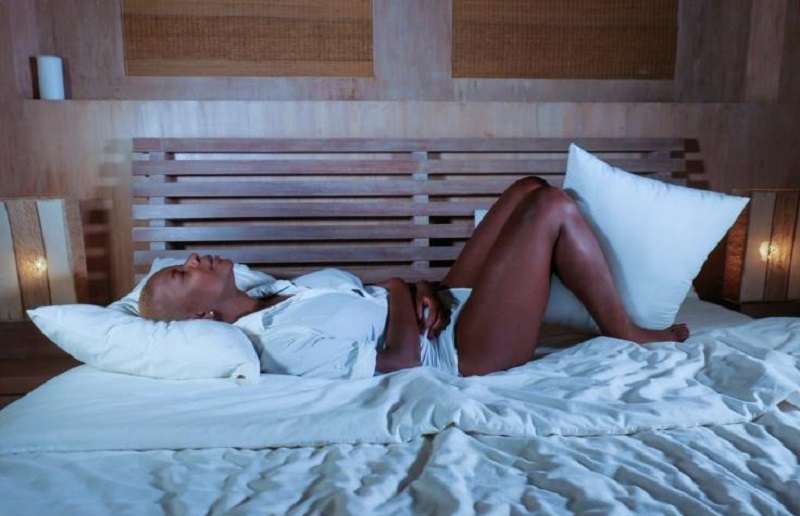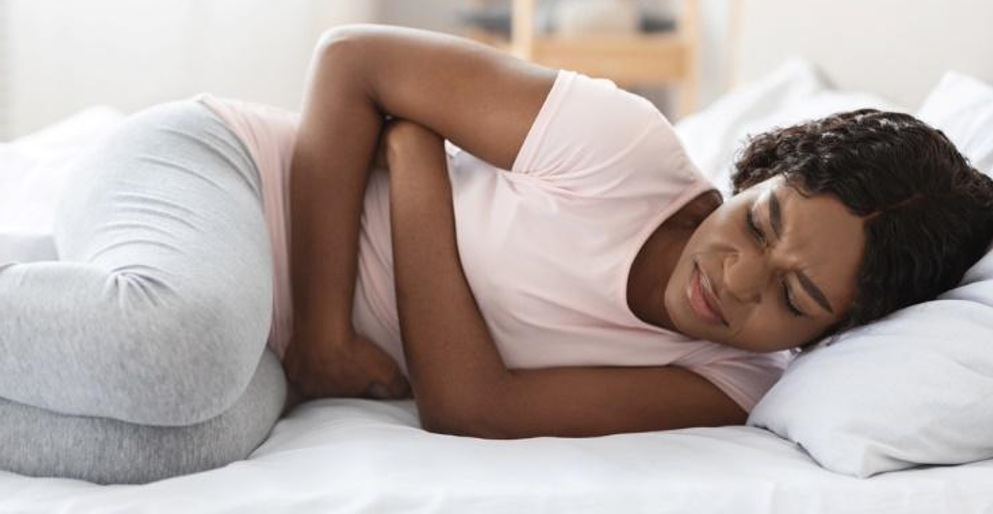Menstrual pain (period cramps) is a frequent visitor to women of reproductive age, particularly in the days before and shortly after the start of a menstrual period. Period cramps can be so intense that sleep is uncomfortable or disrupted.
The pain from menstrual cramps is multifactorial. Hormones called prostaglandins are released around the time of menses to cause pelvic inflammation and pain. At the same time, the uterus is contracting to help shed the uterine lining in preparation for the next cycle. Until the uterine contractions slow down, it can be hard to sleep comfortably.
Fortunately, how you sleep can greatly improve the pain from period cramping. Certain positions during sleep can ease the pain and pressure in your abdomen to help you rest better as you deal with this uncomfortable monthly experience.
The Connection Between Sleep Positions and Period Cramps
Period cramps are only part of the picture during early menstruation. Because the body no longer needs the inner lining of the uterus, the tiny blood vessels (called spiral arteries) dry up, cutting off the circulation to the lining.
Without adequate circulation, this inner lining tissue becomes inflamed, sending out pain-producing prostaglandins and other inflammatory molecules. Your entire belly can feel swollen from extra fluid accumulating in nearby tissues.
When any area of your body is inflamed, swollen, or painful, you’re taught to elevate the affected area. The idea is to reduce the pressure and ease pain. Unfortunately, this isn’t possible when your abdomen feels bloated and inflamed. This is where your sleeping position can help.
The position you sleep in can help manage the pain that comes when your uterus is literally inflamed during the first few days of your period. By sleeping to reduce muscle tension and improve blood flow in the pelvic region, you can manage your pain and sleep nearly as well as at other times of the month.
Best Sleep Positions for Period Cramps
Several sleeping positions can help reduce the pain of period cramps.
Position 1: Fetal Position
The fetal position has been shown to be one of the best sleeping positions for managing menstrual cramps. When you sleep in this position, you reduce the tension on your outer abdominal muscles and maintain warmth within the pelvic region.
This reduces tension and cramping of the uterine muscles and helps enhance blood flow through the region to allow the prostaglandins to flow more quickly out of the pelvis.
Position 2: Back Sleeping with a Pillow Under Knees
When you sleep on your back, you can reduce menstrual cramp pain by placing a pillow beneath your knees. This reduces the tension in your abdominal muscles and keeps your spine aligned.
Less tension translates to reduced pain. You will sleep better and will be less likely to turn over in your sleep. Your back muscles will also be less tense when sleeping in this position. This can also reduce your night-time pain and may result in fewer cramps.
Position 3: Side Sleeping With a Pillow Between Knees
You can sleep on your side and place a pillow between your knees to reduce the tension in your back muscles and maintain spinal alignment. Blood flows more easily through the pelvis when your spine is aligned with equal muscle tension on either side of this critical area of your lower back. Less muscle tension also means reduced pain.
Position 4: Prone Position with a Pillow Under Hips
While you can’t elevate your pelvis as much as you can an arm or leg, you may be able to reduce pelvic pain during your period by lying prone (on your stomach) and placing a pillow beneath your hips in the area of your pelvic bones.
This can reduce pelvic pressure and will automatically lower the tension in the abdominal muscles. This slight elevation, coupled with lower abdominal muscle tension, translates to more comfort in this region when sleeping.
Creating a Tranquil Sleep Haven
It can be incredibly difficult to get through a busy day with period cramping. It becomes worse when you just want to crawl into bed to ease your cramps but still feel miserable. You can help achieve better sleep by creating a comfortable sleeping place with everything you need for a full night’s rest.
Begin this process by creating a more comfortable bed space. Ensure that your bed is medium-firm to fully support you as you sleep. A thin layer of memory foam overlying a supportive mattress can also help achieve a good combination of comfort and support.
Your pillow should also be comfortable. Some women use a body pillow to hug as they sleep or use parts of the body pillow to tuck between their knees for enhanced comfort. You can hug a smaller pillow, too, if that feels better. Make sure you have comfortable pajamas and blankets to add to the tranquility of your sleep experience.
Heat in the form of a hot water bottle or a heating pad set on “low” can further relax your uterine muscles during sleep if you place the heat on your lower belly area or back. Heat also enhances the circulation in the pelvic region to relieve pain.
Even though period pain is uncomfortable, you will sleep better if you actively relax before trying to fall asleep. Mindfulness meditation, yoga, and simple slow breathing techniques can relax your entire body, including your pelvic region. Relaxation reduces your perception of pain, allowing for improved sleep.
Tailoring Sleep Positions to Your Needs

If your period pain is intense enough to interfere with sleep and you think that sleeping in a different sleeping position will help, you may wish to seek medical advice before making any major adjustments. A healthcare professional can advise you on the best way to sleep with menstrual pain for your individual situation.
Your body type may respond best to one sleep position for period pain but not another. You may also have particular preferences that dictate the best position for the menstrual cramps you’re having on any given day.
Learn what works best for you so you can use that information when your monthly cramps begin in the months and years to come.
Conclusion
Period cramps do not have to disrupt your sleep entirely. Specific sleep positions can help reduce abdominal muscle tension, settle uterine muscle cramping, and enhance blood flow in the pelvis to reduce inflammation and encourage healing of the tissues.
Keep the different positions just mentioned in mind and use them the next time your period cramps threaten to derail your sleep. On any given night, try one or more positions to see if your menstrual cramps lessen.
Don’t forget to relax before going to bed and use local heat on your back or abdomen if that further improves your symptoms. Be creative and adapt your sleep position to find what feels the best for you during the more painful nights of your period.

